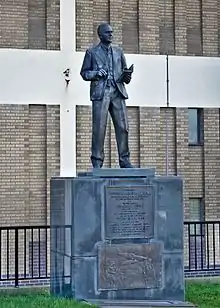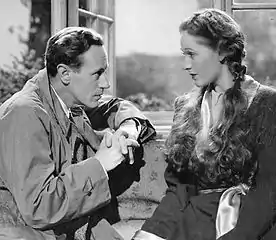R. J. Mitchell
Reginald Joseph Mitchell CBE, FRAeS, (20 May 1895 – 11 June 1937) was a British aircraft designer who worked for the Southampton aviation company Supermarine from 1920 to 1936. He is best remembered for designing racing seaplanes such as the Supermarine S.6B, and the Supermarine Spitfire.
Reginald Joseph Mitchell | |
|---|---|
 R. J. Mitchell, aeronautical engineer | |
| Born | 20 May 1895 |
| Died | 11 June 1937 (aged 42) |
| Occupation | Aeronautical engineer |
| Known for | Supermarine S.6B Supermarine Spitfire |
| Spouse(s) | Florence Dayson |
| Children | Gordon Mitchell |
| Parent(s) | Herbert Mitchell and Eliza Jane Brain |
| Awards | CBE |
Born in Butt Lane, Staffordshire, Mitchell attended Hanley High School and afterwards worked as an apprentice at a locomotive engineering works, whilst also studying engineering and mathematics at night. In 1917 he joined Supermarine, where he was appointed Chief Engineer in 1920 and Technical Director in 1927.
Between 1920 and 1936 he designed 24 aircraft, which included flying boats and racing seaplanes, light aircraft, fighters, and bombers. From 1925 to 1929 he worked on a series of racing seaplanes, built by Supermarine to compete in the Schneider Trophy competition, the final entry in the series being the Supermarine S.6B. The S.6B won the trophy in 1931, and that year he was awarded the CBE. When in 1931 the Air Ministry issued specifications for a new fighter aircraft, Supermarine submitted Mitchell's design, the Type 224, but this was rejected by the RAF. Mitchell was then authorised by Supermarine to proceed with a new design, the Type 300, which went on to become the Spitfire.
In 1933, he underwent surgery to treat rectal cancer. He continued to work and earned his pilot's licence in 1934, but in early 1937, he was forced by a recurrence of the cancer to give up work. After his death that year, he was succeeded as Chief Designer at Supermarine by Joseph Smith.
Early life
Reginald Joseph Mitchell was born at 115 Congleton Road, Butt Lane, in Staffordshire.[1] After leaving Hanley High School, a grammar school in Stoke-on-Trent, at the age of 16, he gained an apprenticeship at Kerr Stuart & Co. of Fenton, a locomotive engineering works.[2] At the end of his apprenticeship he worked in the drawing office at Kerr Stuart and studied engineering and mathematics at night school.
Early career

In 1917 he joined the Supermarine Aviation Works at Southampton. Advancing quickly within the company, Mitchell was appointed Chief Designer in 1919.[2] He was made Chief Engineer in 1920 and Technical Director in 1927. He was so highly regarded that when Vickers took over Supermarine in 1928, one of the conditions was that Mitchell stay as a designer for the next five years.
Between 1920 and 1936, Mitchell designed 24 aircraft. As Supermarine was primarily a seaplane manufacturer, this included several flying boats such as the Supermarine Sea Eagle, the Supermarine Sea King, the Supermarine Walrus, and Supermarine Stranraer, and racing seaplanes. Mitchell also designed light aircraft, fighters, and bombers.
He was first noted in this period for his work on a series of racing seaplanes, built by Supermarine to compete in the Schneider Trophy competition. The Supermarine S.4 was entered in 1925, but crashed before the race. Two Supermarine S.5 aircraft were entered in 1927, and finished first and second. The Supermarine S.6 won in 1929. The final entry in the series, the Supermarine S.6B, marked the culmination of Mitchell's quest to "perfect the design of the racing seaplane".[3] The S.6B won the Trophy in 1931 and broke the world air speed record 17 days later.
Mitchell was awarded the CBE on 29 December 1931 for services in connection with the Schneider Trophy Contest.[4]
Supermarine Spitfire
The technical skill that Mitchell used in the design of the Spitfire was developed in the evolution of the Schneider Trophy seaplanes. The significance of the many earlier planes is often overlooked when people refer to Mitchell, as is the fact that he was very concerned about developments in Germany and feared that British defence needed to be strengthened, especially in the air.
In 1931 the Air Ministry issued specification F7/30 for a fighter aircraft to replace the Gloster Gauntlet. Mitchell's proposed design, the Type 224 was one of three designs for which the Air Ministry ordered prototypes.
The Type 224 first flew on 19 February 1934, but was eventually rejected by the RAF for unsatisfactory performance. While the 224 was being built, Mitchell was authorised by Supermarine in 1933 to proceed with a new design, the Type 300, an all-metal monoplane that became the Supermarine Spitfire. This was originally a private venture by Supermarine, but the RAF quickly became interested and the Air Ministry financed a prototype.
Many of the technical advances in the Spitfire had been made by others: the thin elliptical wings were designed by Canadian aerodynamicist Beverley Shenstone, and shared some similarities with the Heinkel He 70 Blitz; the under-wing radiators had been designed by the RAE, while monocoque construction had been first developed in the United States. Mitchell's genius was bringing it all together with his experience of high speed flight and the Type 224.
The first prototype Spitfire, serial K5054, flew for the first time on 5 March 1936 at Eastleigh, Hampshire. In later tests, it reached 349 mph; consequently, before the prototype had completed its official trials, the RAF ordered 310 production Spitfires. Mitchell is reported to have said that "Spitfire was just the sort of bloody silly name they would choose.[5]
Later years
In August 1933, Mitchell underwent a colostomy to treat rectal cancer. Despite this, he continued to work, not only on the Spitfire, but also on a four-engined bomber, the Type 317. Unusually for an aircraft designer in those days, he took flying lessons and got his pilot's licence in July 1934.
In 1936 cancer was diagnosed again, and subsequently, in early 1937, Mitchell gave up work, although he was often seen watching the Spitfire being tested. Mitchell went to the American Foundation in Vienna for a month, but died on 11 June 1937 at the age of 42. His ashes were interred at South Stoneham Cemetery, Hampshire, four days later.[6][lower-alpha 1]
Legacy

Mitchell was succeeded as Chief Designer at Supermarine by Joseph Smith, who was responsible for the further development of the Spitfire. Nevertheless, Mitchell's design was so sound that the Spitfire was continually improved throughout World War II. Over 22,000 Spitfires and derivatives were built.
Commemorations

Mitchell's career was dramatized in the biographical film The First of the Few (1942). He was portrayed by Leslie Howard, who also produced and directed the film, released in the United States as Spitfire (1943).[7] At a special showing of the film in 1943, an appeal was launched for the Reginald Mitchell Memorial Fund (later the Spitfire Mitchell Memorial Fund) to raise money for a centre for youth in Stoke-on-Trent[8] The Mitchell Memorial Youth Theatre, now known as Mitchell Arts Centre, was opened in Stoke-on-Trent in 1957 after £50,000 was raised by public subscription..[9][10]
In 1959, the primary school close to his birthplace, originally called Butt Lane Junior School, was renamed as the Reginald Mitchell County Primary School,[11] and Hanley High School was renamed Mitchell High School in 1989.[12] The R J Mitchell Primary School at Hornchurch is also named after Mitchell.[13]
In 1986 Mitchell was inducted into the International Air & Space Hall of Fame at the San Diego Air & Space Museum.[14] The American philanthropist Sidney Frank unveiled a statue of Mitchell at the Science Museum, London in 2005.[15] The slate drawing board's surface depicts the drawing of the prototype Spitfire K5054 from June 1936. The stone sculpture was created by Stephen Kettle and given to the museum by the Sidney E. Frank Foundation.[16]
An English Heritage blue plaque was dedicated at his home at Portswood, Southampton in 2005.[17] Earlier that year a blue plaque from the Newcastle Civic Society was dedicated at Mitchell's birthplace in Butt Lane.[18]
Notes
- South Stoneham cemetery is not located at either South Stoneham Church or North Stoneham Church. The cemetery where Mitchell is buried is located approximately 1 km between the two churches.
References
- Richie 2004.
- Price 2002, p. 11.
- Price 1977, p. 11.
- "To be commanders of the Civil Division of the said Most Excellent Order". The London Gazette (Supplement: 33785). 29 December 1931. p. 8. Retrieved 4 October 2020.
- Deighton 1977, p. 99.
- Mitchell 2002.
- "The First of the Few". British Film Institute. Retrieved 22 November 2020.
- Mitchell 2002, p. 248.
- Mitchell 2002, p. 250.
- Kent-Baguley, Peter (2007). Mitchell Memorial Youth Theatre 50th Anniversary. Stoke-on-Trent City Council. p. 9.
- Mitchell 2002, p. 251.
- Mitchell 2002, p. 253.
- "History of our School: R.A.F. Hornchurch and R.J. Mitchell". The R J Mitchell Primary School. Retrieved 22 December 2020.
- Sprekelmeyer 2006.
- "Fitting tribute to the man who created the Spitfire". Birmingham Post. 16 September 2005. Retrieved 16 December 2015.
- "Stone sculpture of R. J. Mitchell". Science Museum. Archived from the original on 22 December 2015. Retrieved 17 December 2015.
- "Plaque for Spitfire man's city home". Southern Daily Echo. 8 September 2005. Retrieved 4 October 2020.
- Mitchell 2002, p. 253–254.
Works cited
- Deighton, Len (1977). Fighter: The True Story of the Battle of Britain. London: Grafton. ISBN 978-0-7858-1208-1.
- Mitchell, Gordon (2002). R.J. Mitchell: Schooldays to Spitfire. London: Tempus Publishing. ISBN 978-0-7524-3727-9.
- Price, Alfred (1977). Spitfire: A Documentary History. New York: Macdonald and Jane's. ISBN 978-0-684-16060-3.
- Price, Alfred (2002). The Spitfire Story. London: Silverdale Books. ISBN 978-1-85605-702-8.
- Richie, Sebastian (2004). "Mitchell, Reginald Joseph". Oxford Dictionary of National Biography. Oxford University Press. OCLC 56568095. Retrieved 15 December 2020. (subscription may be required or content may be available in libraries that are in the UK)
- Sprekelmeyer, Linda, ed. (2006). These We Honor: The International Aerospace Hall of Fame. Donning Co. ISBN 978-1-57864-397-4.
Further reading
- Dibbs, John; Holmes, Tony (1997). Spitfire: Flying Legend. Southampton: Osprey Publishing. ISBN 978-1-84176-005-6.
- Eforgan, Estel (2010). Leslie Howard: The Lost Actor. London: Vallentine Mitchell. ISBN 978-0-85303-941-9.
- McKinstry, Leo (2007). Spitfire: Portrait of a Legend. London: John Murray. ISBN 978-0-7195-6874-9. (registration required)
- Quill, Jeffrey (1983). Spitfire: A Test Pilot's Story (1st ed.). London: Crécy Publishing. ISBN 978-0-947554-72-9.
- Pegram, Ralph (2016). Beyond the Spitfire - The Unseen Designs of R.J. Mitchell. Brimscombe Port: The History Press. ISBN 978-0-7509-6515-6.
- Shelton, John (2008). Schneider Trophy to Spitfire - The Design Career of R.J. Mitchell (Hardback). Sparkford: Hayes Publishing. ISBN 978-1-84425-530-6.
External links
| Wikimedia Commons has media related to R J Mitchell. |
- RJ Mitchell. A life in aviation.
- Local Heroes: Reginald (RJ) Mitchell from the BBC
- Spitfire legend, a 2005 interview with Gordon Mitchell about his father (Southern Daily Echo)